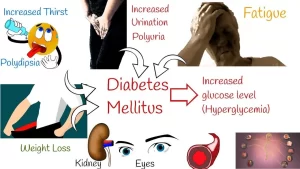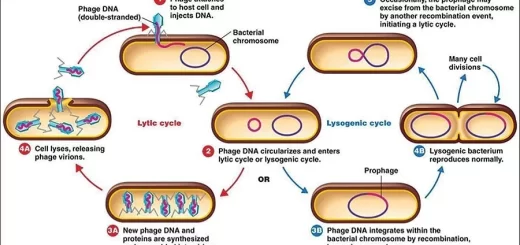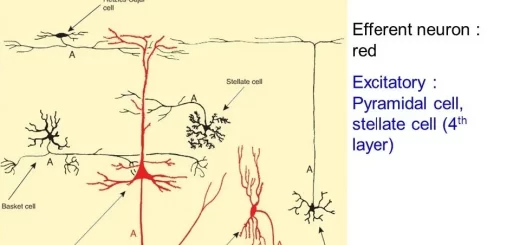Diabetes mellitus symptoms, causes, types and sources of glucose in the blood
Diabetes mellitus is known simply as diabetes, It is a group of common endocrine diseases characterized by sustained high blood sugar levels, Diabetes is due to either the pancreas not producing enough insulin, or the cells of the body becoming unresponsive to the hormone’s effects, Classic symptoms include thirst, polyuria, weight loss, and blurred vision, when left untreated.
What is Diabetes Mellitus?
It is a disease characterized by impaired carbohydrate metabolism, namely glucose metabolism. The main cause is either insulin deficiency or insulin resistance, which leads to the accumulation of glucose in the blood and hence elevated blood glucose levels. Fat and protein metabolism are eventually impaired. The classical presentation of diabetes mellitus is increased output of urine (polyuria), increased thirst (polydipsia), and increased hunger (polyphagia).
Diabetes mellitus is a disease of inadequate control of blood levels of glucose, It has many subclassifications, including type 1, type 2, maturity-onset diabetes of the young (MODY), gestational diabetes, neonatal diabetes, and steroid-induced diabetes.
The disease can lead to various health complications, including disorders of the cardiovascular system, eyes, kidneys, and nerves, Untreated or poorly treated diabetes accounts for approximately 1.5 million deaths every year.
Diabetic Profile
Group of tests that are used to diagnose diabetes mellitus and to measure response to treatment. They include:
- Blood Glucose level estimation: fasting blood glucose, post prandial, random blood glucose, Oral glucose tolerance test (OGTT).
- HbAlc.
- C-peptide and insulin levels.
- ICA (Islet cell antibodies).
Colorimetric determination of Serum/Plasma Glucose level
Glucose is the primary energy source for the human body:
Sources of glucose in the blood
- Dietary carbohydrates: After digestion and breakdown of carbohydrates in the diet, glucose is derived by its absorption, and a state of postabsorptive hyperglycaemia is realized.
- Glycogenolysis: Free blood glucose can be derived from the liver stores of glycogen.
- Gluconeogenesis: Blood glucose is derived through its endogenous synthesis from non-carbohydrate sources e.g. from amino acids, lactate, and glycerol.
Estimation of fasting serum glucose level: Normal value (fasting) = 60-110 mg/dl
Causes of increased serum glucose level (HYPERGLYCEMIA)
- Diabetes Mellitus.
- Hyperthyroidism.
- Hypopituitarism.
- High epinephrine: severe emotional stress, pheochromocytoma.
- Gestational diabetes.
Causes of decreased serum glucose (HYPOGLYCEMIA)
- Hyperinsulinism
- Hypopituitarism
- Fructose-induced hypoglycemia (deficiency of aldolase B).
- Overdose of insulin or oral hypoglycemic drugs.
- Glycogen storage diseases in the liver.
Principle of glucose estimation by colorimetry (By Enzymatic method);
1) Glucose → Gluconic acid + H₂O₂
2) 2 H₂O₂+ phenol + 4-amino-antipyrine
Procedure
Prepare three dry, clean glass tubes and label them blank, standard, and sample, add 1ml reagent in each:
- In one test tube add 10 µl sample.
- In the second test tube add 10 ul standard.
- In the tube for the blank, you may add 10 μl water.
Use the colorimeter to the absorbance of the sample and the standard against the blank at 510 mm. (490-530 nm).
the color is stable for 30 min.
Calculation:
Glucose in the sample = (A sample/ A standard) X 100 mg/dl
Glucose Tolerance
It is the ability of the body to utilize glucose.
Indications for oral Glucose tolerance tests (OGTT):
- The patient has symptoms suggestive of diabetes mellitus but the blood sugar value is inconclusive (between 110 and 126 mg/dl).
- During pregnancy.
- To rule out benign renal glucosuria.
Contraindications for OGTT
- There is no indication for doing OGTT in a person with confirmed diabetes mellitus.
- OGTT has no role in the follow-up of diabetes, it is indicated only for initial diagnosis.
- In general, a GTT should not be performed on patients with acute illnesses, or hospitalized or inactive patients.
In the classical Two Hour OGTT (with 75-gram Glucose Challenge)
- The patient comes fasting and a blood sample is withdrawn for determination of fasting serum glucose level.
- The patient is asked to orally a standard dose of 75 g of glucose.
- A blood sample is withdrawn & urine sample is collected every 30 minutes for 2-3 hours.
- Serum glucose level is determined in each sample and urine is checked for the presence of glucose and the results are plotted against time.
- The resultant curve is known as the glucose tolerance curve.
The following features are present in normal individuals:
- Fasting level: usually between 60-110 mg/dl.
- After taking the oral glucose dose: Absorption occurs rapidly and the blood glucose concentration increases, This stimulates the secretion of insulin for better utilization of the absorbed glucose.
- 30-60 minutes: (at the maximal value of the curve)
- Scrum glucose level reaches its maximal value but is still below the renal sugar, threshold (RST), Before this value (at the ascending limb of the curve), the rate of absorption is greater than the rate of utilization while, After this value (at the descending limb of the curve), the rate of utilization is greater than the rate of absorption.
Gestational diabetes
Any degree of glucose intolerance with onset or first recognition during pregnancy.
Renal glucosuria
The urine contains glucose while the plasma glucose level is still below the normal renal threshold < 180 mg.
Causes
- Genetically inherited low renal threshold.
- Late pregnancy.
- Tubular reabsorption defect e.g. Fanconi syndrome.
HbA1c (Glycosylated hemoglobin)
It indicates how well diabetes has been controlled in the 2 to 3 months before the test. Normal Value: 4.5% -5.7%.
C-peptide level
It differentiates between type I and II diabetes, A person whose pancreas does not make any insulin (type 1 diabetes) has a low level of insulin and C-peptide, and a person with type 2 diabetes has a normal level of C-peptide, Fasting normal value: 0.51-2.72 ng/ml.
Fructosuria
- Means the presence of fructose in urine.
- It is a disorder usually seen in children, in which the body is unable to metabolize the natural sugar fructose.
Causes
- Essential fructosuria: due to deficiency of fructokinase enzyme. It is a harmless asymptomatic condition.
- Hereditary fructose intolerance:
- due to a deficiency in the aldolase B enzyme.
- F-1-P will be accumulated leading to inhibition of glycogen phosphorylase, thus preventing the breakdown of glycogen leading to hypoglycemia.
- In addition, the entrapment of phosphorous in the liver leads to the inhibition of metabolism in the liver.
Test for fructosuria
- Fructose in urine can be tested for by Seliwanoff’s test
- To 5 ml of seliwanoff’s reagent in a test tube add about 1 ml of urine and boil for a few minutes, a red color is produced. This indicates the presence of fructose in urine.
- Seliwanoff’s reagent consists of 0.05 g resorcinol in 100 ml of 10% HCl.
You can subscribe to Science Online on YouTube from this link: Science Online
You can download the Science Online application on Google Play from this link: Science Online Apps on Google Play
Blood analysis, Hemolysis, importance, structure, types, and hemolysis test results
Control of insulin secretion, diabetes mellitus, Glucagon, Somatostatin & features of DNES
Histology of pancreas, Structure of islets of Langerhans, Insulin function & Metabolism




